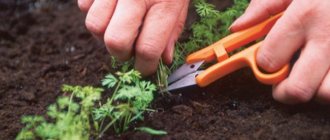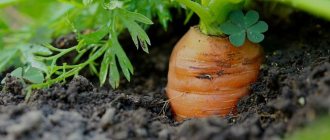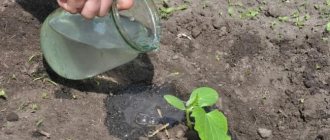A simple and familiar vegetable, zucchini has its own nuances of planting and care. Experienced gardeners have known them for a long time, but novice farmers have many questions. How to plant zucchini, in which place they grow best, what varieties to choose - these problems have to be solved before the planting time. An unpretentious vegetable gives good germination and a bountiful harvest. You can plant it with seeds or seedlings, the main thing is to do it on time and properly prepare the bed.
Landing rules
Zucchini is an annual herbaceous plant imported from Mexico. In memory of his homeland, he retained his love of open sunny areas. This pumpkin variety is distinguished by powerful stems and large five-lobed leaves. The fruits are mostly oblong, cylindrical, but sometimes round. The shape of the plant is either bushy or climbing. Bush varieties are more often grown in gardens: “Gribovsky”, “Belogor”, “Aeronaut”, “Iskander F1”.
The compact crop takes up little space, allowing you to adhere to a specific planting pattern. Bush zucchini produce a good harvest and are easy to care for. The climbing form requires more free space in the garden. The crop throws out lashes 3-4 m long. The advantage of vegetables is their excellent taste. Breeders have developed interesting varieties that produce short branches: “Aral”, “Karam”, “Waterfall”.
How to properly plant zucchini in open ground - seedlings or seeds? Both options are suitable for growing crops. In the first case, the fruits will appear 14-15 days earlier. When planning to grow zucchini, remember that they are more demanding on the structure and fertility of the soil than other pumpkin crops. Before planting vegetables, it is necessary to fertilize the soil well with compost and minerals. Nutrient content is laid in the fall. In flooded areas, farmers are advised to divide the mineral fertilizer into two parts. Use one before winter, and the second in spring. Beneficial substances will not be washed out with precipitation and melt water.
Tips for improving soil structure from experienced gardeners:
- Clay soil - per 1 sq. m add 5 kg of river sand, 2 kg of peat, 3 kg of humus and the same amount of sawdust.
- Peat - you will need a bucket of clay, 2 kg of compost, superphosphates and wood ash. It is recommended to water the area with Agricola-5 fertilizer. It is diluted according to the instructions, 3 liters of the composition is enough.
- Sandy soil - add 8 kg of turf soil and peat, 3 kg of sawdust and the same amount of humus.
- Chernozem is good in itself, but adding sawdust will make it looser.
Proper planting is done taking into account crop rotation. Proper alternation of plants can significantly increase the yield, and miscalculations result in poor fruiting. The soil for vegetables is prepared in the fall, carefully dug up, and the remaining weeds are buried in the ground. At the same time, add manure and compost. By the beginning of the next growing season it will only have to be leveled. In the southern regions, vegetables are grown directly on the plot. Farmers in the northern regions use raised beds and film insulation.
Information. In cold soil, seeds do not germinate, and those planted with sprouts stop developing. You should not start work until the ground warms up to 12-14°C.
Is it necessary to cover seedlings after planting? This question is asked more often than others. The heat-loving crop does not tolerate low temperatures; at temperatures below +5°C, the seedlings die. The advice of experienced gardeners is clear - if there is a threat of returning cold weather, it is necessary to provide protection. Typically, lightweight temporary structures are installed from arches or wooden frames over which plastic film is stretched. During the day it reclines for ventilation, and in the evening it lowers. It is important that the polyethylene with condensation formed does not touch the leaves of the seedlings. In mid-June, the shelter is dismantled and removed until next year.
Advice. Place 5-liter bottles of water under the film. These are kind of heat accumulators. During the day they heat up in the sun, and at night they give off the temperature inside the makeshift greenhouse.
Selecting a location and preparing the bed
Zucchini is a light-loving and heat-loving plant, so it needs to be grown on the sunny side of a bed 60-70 cm wide. This can be a small area for growing several plants. It is important that no other representatives of the Pumpkin family were previously grown in this place, otherwise the zucchini will become sick and produce a lot of barren flowers. To maintain garden crop rotation, they are best grown after the following crops:
- tomatoes;
- potatoes;
- cabbage;
- Luke;
- root vegetables;
- greenery;
- legumes
Zucchini themselves are good predecessors for all vegetables, with the exception of representatives of the Cucurbitaceae. Their roots perfectly loosen the soil, and large leaves prevent the development of most weeds.
It is equally important to choose an area where the soil is optimal for zucchini. The best option for them is considered to be loamy or sandy loam fertile soils with a neutral reaction (pH 6.5-7.5). Zucchini grows poorly on peat soils - the fruits are small and the leaves grow poorly. Heavy clay soils are unsuitable for this crop.
To ensure that the soil is fertile and loose, 12-15 days before planting, it is worth digging up the area to the depth of a shovel, having previously added 1 square meter. m:
- 0.5-1 bucket of humus or rotted compost;
- 1-1.5 buckets of rotted sawdust;
- 1 tbsp. l. urea and potassium sulfate;
- 2 tbsp. l. superphosphate;
- 2 cups wood ash.
To spend less fertilizer, they can be applied directly to the planting holes at a distance of 80 cm from each other, and then mixed well with the soil. Next, the bed will need to be watered with hot water and covered with film before planting the zucchini.
The order of fertilizer application can be adjusted depending on the composition of the soil:
- Peat . For 1 sq. m you need to add 2 kg of compost or humus, 1 bucket of loamy or clay soil, 1 tsp. superphosphate and potassium sulfate, 2 tbsp. l. ash. Next, a bed 65-70 cm wide should be dug up to a depth of 20-25 cm and leveled with a rake. It must be watered with a warm (40°C) solution of liquid fertilizer Agricol-5 or Rossa (1 tbsp per bucket of water) at the rate of 3 liters per 1 sq. m. m. At the end, all that remains is to cover the bed with film to retain moisture and heat.
- Clayey, loamy . For 1 sq. m, it is enough to add 2-3 kg of peat, sawdust and humus. As mineral fertilizers, it is worth introducing 1 tbsp. l. superphosphate and 2-3 tbsp. l. wood ash.
- Sandy . Every sq. m should be fertilized with 1 bucket of turf soil (clayey, loamy) and the same amount of peat. Next you need to add 3-4 kg of sawdust and humus, as well as 1 tbsp. l. superphosphate and 2-3 tbsp. l. wood ash.
- Chernozem . For every sq. m of fertile soil, it is advisable to add 2 kg of sawdust, 2 tbsp. l. ash and 1 tbsp. l. superphosphate.
- Dense, heavy and poor . In such soils it is worth adding manure or compost in the fall (4-6 kg per 1 sq. m), as well as complex mineral fertilizers for vegetables (50-80 g per 1 sq. m). It is advisable to water the bed with a weak solution of potassium permanganate, and loosen it a little just before sowing the zucchini.
If a plot of land is being developed for the first time for growing zucchini, then when digging it, you should carefully remove all the roots from the soil, as well as catch and destroy cockchafers and wireworms.
Immediately before planting, fresh manure should not be added to the soil, as this can lead to the development of various diseases in young seedlings, active growth of green mass and poor fruiting.
How to plant zucchini in open ground with seeds
One way to plant zucchini is with seeds in open ground. When can you start farming? Sowing begins with the onset of persistent heat, the daytime air temperature should be 22-25°C, and the soil should warm up to 10-12°C. Such indicators are typical for the southern regions in early May; in the middle zone and Moscow region, favorable conditions begin at the end of May or the first ten days of June.
Beginners are afraid to delay planting time, so they are interested in how long the seeds can be planted. In regions with a temperate climate, it is advisable to complete sowing before June 15-20. It should be borne in mind that the plant needs 45-55 days to reach fruit ripeness. Planting takes place in soil that has been well fertilized in the fall. In the spring, the beds are straightened, loosened and leveled.
When choosing seeds, several factors are taken into account:
- timing of fruit ripening (early, middle and late);
- name of the manufacturer, well-known companies offer high-quality seed;
- a hybrid or varietal plant, not only the quality characteristics depend on this, but also the ability to use seeds from the fruits for further sowing;
- Shelf life – usually it is 5-8 years.
Advice. If zucchini is planted in several stages at intervals of a week, then the period for reaching technical ripeness will also be extended.
Pre-sowing preparation
To improve seed germination and speed up their germination, stage-by-stage processing is carried out. First, high-quality material is selected - full-fledged and without external defects. Then gardeners act in different ways:
- Soak the seeds for 20-30 minutes in one of the growth stimulants “Zircon”, “Epin”, “Ecosila”. Then placed in a damp cloth for germination. Thin white roots appear after 2-3 days. The room temperature should be 23-25°C.
- Place the seeds in hot water (up to 50°C) for 4-5 hours. After this, place it in cold water for a few minutes.
Advice. To disinfect the material and prevent fungal infections, homemade seeds are treated with a solution of potassium permanganate or Fundazol.
Most seeds from foreign producers are hybrid. They underwent all the necessary training at the factory. Some farmers keep them in a damp cloth until germination. Others believe that in nature the seeds germinate dry, so they are planted without preparation. For mass planting, the percentage of germination is calculated. The seeds are placed in a box with wet sawdust. After 2-3 days, they look inside and count the number of roots that have hatched. It is easy to calculate germination if you take 10 seeds.
Information. One of the secrets to successful seed germination is heating the bag on a radiator.
Soil planting technology
For a sprout to appear, three basic conditions must be present: water, air and heat. The impetus for the germination of a dormant seed is given by moisture. Water enters through microscopic holes in the peel. The beginning processes create high pressure. We plant the seeds in the garden bed already swollen and ready to germinate. The spine appears first. It anchors in the soil and begins to supply nutrition to the plant. The root always points downwards, even if you place the seed with the pointed end up.
Small holes are dug under them, each one is spilled with warm water. How many seeds should I put in one hole? Usually 2-3 pieces are dropped, if they all sprout, they leave a strong sprout, and pinch off the rest. One of the important points is which end to plant, sharp or blunt. All melon seeds have a similar structure; a root emerges from their sharp tip, and cotyledon leaves emerge from the blunt tip. In fertile soil at high temperatures, the zucchini will quickly appear on the surface, regardless of how the seed is positioned.
When choosing which side to plant seeds, farmers recommend placing them horizontally in the hole, preferably on the edge. Planting depth plays a decisive role. On heavy soils it is 3-5 cm, on light soils – 5-6 cm. This distance allows the seedlings to appear on the surface in 4-6 days and get rid of the shell during the growth process. You will find out the exact timing of the appearance of seedlings in the article “How many days will it take to wait for the first shoots - how quickly do zucchini sprout?”
The top surface of the bed is mulched with humus, straw or peat. This agrotechnical technique is relevant for seedlings. It prevents the formation of a dense crust on the soil. It will be more difficult for the zucchini sprouts to break through the obstacle. The optimal period when to plant vegetables is the second ten days of May, but the weather in spring is unpredictable. At any moment, the night temperature can drop to 0°C. The heat-loving crop will die in such conditions. Knowing about temperature fluctuations, gardeners prudently cover their crops.
Bottle planting technology
To preserve seedlings, use polyethylene film. The method of planting under a bottle is no less popular. The technology is simple, reminiscent of a mini-greenhouse. The number of plastic bottles is equal to the number of holes. A container with a cut bottom and a screwed lid is placed above each planting. Light bottles with a volume of 2-5 liters are used. The protective structure is buried 2-3 cm into the ground for stability.
The first time after planting, the caps of the bottles are not unscrewed. In hot weather, when temperatures reach 20°C, they must be removed. Watering the zucchini is carried out around the installed container. When the seedlings grow, they begin to harden off, leaving them overnight with the lid open. By June, the bottles are completely removed. This technology allows you to plant pumpkin seeds in open ground earlier than usual.
Preparing zucchini seeds
Zucchini sowing occurs when the air temperature no longer drops below +10...+12 °C; this time in most regions occurs at the end of May and the beginning of June. In the northern regions, planting dates are often shifted to early July. To improve germination and speed up the harvest time, it is necessary to prepare the seed material in advance in a special way.
The seed preparation technology consists of the following manipulations:
- the seeds are carefully sorted, discarding empty and damaged ones;
- soak for several minutes in a weak solution of potassium permanganate, discard any floating specimens;
- the seeds that have settled to the bottom of the container are removed and re-soaked in a solution of any growth stimulator (Epin, Zircon and others) for 20-30 minutes;
- then the seeds are filtered, rinsed with lukewarm water and wrapped in a damp cloth to swell for several hours;
- the swollen but not yet germinated seed is placed in the refrigerator for stratification for 2 days (at a temperature of about 0 °C);
- then the bundle is placed in a well-lit, warm place (on a windowsill) for several days, the fabric is periodically moistened;
- When the roots reach a length of approximately 0.5-1 cm, the seeds can be planted.
You should try to plant sprouted seeds as soon as possible; this process cannot be delayed. Since the roots grow quickly, then when planting they can intertwine with each other and break off. A damaged seed will no longer sprout.
How to plant zucchini seedlings in open ground
What is the best way to plant zucchini: seeds or seedlings? Of the two methods practiced when planting zucchini, the seedling method is more complex and costly. The reason why it is quite popular is the opportunity to get pumpkins 14-15 days earlier than when planting seeds in the ground. When growing vegetables in short summer conditions, this is the only way to get a good harvest.
Preparations for cultivation begin with the selection of containers. Zucchini has fragile roots, so general planting and picking are not recommended. A separate container is immediately selected for each plant. Its size is 10x10 cm; disposable plastic or peat cups are suitable. In the first case, the seedlings are taken out along with a lump of earth, in the second case they are simply placed in the hole. The likelihood of root damage is minimized.
You can buy soil for plants ready-made in the store or make it yourself. In this case you will need:
- peat;
- sawdust:
- ash;
- compost.
The substrate components are mixed in a ratio of 5:2:2:1. Recommended brands of ready-made soil are “Miracle Bed” and “Vegetable Universal”.
How to plant correctly, step-by-step instructions:
- Pour water over the seeds and discard any that float.
- As a disease prevention, zucchini's immunity is strengthened. They are placed in hot water for 5 hours, then in cold water for 5 minutes.
- Seeds are placed in a damp cloth for germination. Keep in a room with a temperature of 24-25°C. It is not recommended to use gauze; the roots get tangled in its mesh structure.
- After small white roots appear, plant the seeds in separate pots with soil to a depth of 2-3 cm. Before sowing, the ground is treated with a light pink solution of potassium permanganate.
- The soil is moistened with warm water from a sprayer.
- The cups are covered with plastic bags to create greenhouse conditions. They are left on a bright windowsill at a temperature of 23-26°C. Shoots appear after 4-6 days.
For seeds collected from their own fruits, a fungicide treatment procedure is required. Store-bought material is usually already processed; this can be easily determined by the inscription on the bag and the color of the seeds. They do not need heating and disinfection before sowing. The time when you need to plant seeds for seedlings depends on the climatic conditions in the region. This period extends for a month, starting from April 10 to May 10-12.
Information. To store fresh zucchini for a long time, vegetables are planted in July. Seedlings for late planting are prepared from June 15-20.
Seedling care
A bountiful harvest is obtained from healthy and strong seedlings. After emergence of seedlings, the temperature is reduced to 15-20°C. Seedlings require good and long-lasting lighting, otherwise the stems will become very elongated. The best place to place seedlings is south windows. In other areas, additional lighting may be needed. Watering is carried out only with warm, settled water. Moisture pours onto the soil near the plant. The mode depends on the drying speed of the top layer of soil. The moisture volume is about 100 ml per seedling.
Advice. Do not overwater the seedlings, otherwise they may get sick. Growing cups must have holes to allow excess water to drain out.
During the period of growing at home, seedlings need to be fed twice. The first application of fertilizers occurs on the 10th day after germination. They use the drug “Bud”, which stimulates plant development. Take 2 g per 1 liter of water. You can prepare a urea solution, 3-5 g is enough. After 10 days, the zucchini is fed a second time. Half a teaspoon of “Nitrophoska” and wood ash are dissolved in a liter of warm water. Up to 20 ml is poured under the plant. Fertilizers are applied after watering so that the high concentration of microelements does not burn the roots.
By the time of transplanting into the ground, the seedlings should have two true leaves. A week before this moment, the seedlings begin to adapt to street conditions. During the daytime, they are taken out onto the balcony or veranda. The optimal age of seedlings for planting in the ground is 20-25 days. But it's always good to have a few days left. If, when the seedlings reach three weeks of age, weather conditions do not allow planting, it is postponed. Don't wait longer than 30 days. The timing of planting seedlings is the end of May, the beginning of June. During this period, the average daily temperature should not fall below 15°C.
Information. In order not to waste money on buying containers for seedlings, they use various available materials. Seedlings are grown in milk or juice cartons and homemade paper cups.
Zucchini is a large crop and needs room to grow. Free planting is also a preventive measure for fungal diseases. At what distance should I plant seedlings? The recommended intervals between holes are 70-80 cm. When preparing a place for crops, the future neighborhood is taken into account. Favorable companions: cabbage, onions, beets, corn. To plant seedlings in the garden, choose a cloudy day or afternoon. Under the sun's rays, it will be more difficult for the plant to adapt to a new location.
To make it easier to remove the soil from the cups, it is pre-watered. Homemade bags are cut, freeing the root system. Spacious holes are dug for the seedlings. To each add 100 g of humus, a spoonful of ash and superphosphates. The soil is watered with warm water. The seedlings with a lump of earth are placed in the middle of the hole, sprinkled with soil and lightly compacted. The seedling is buried down to the cotyledon leaves. If the weather forecast reports cold weather, the plants are hidden under plastic bottles or film.
When vegetables grow, they need watering once a week. Before flowering, pour 5 liters of warm water under the bush. During the period of flower formation and fruit growth, moisture is increased by 2 times. Some gardeners place a film under the pumpkins to prevent the fruits from lying on wet ground. Vegetables are fed three times per season. They use diluted manure, herbal infusion, and mineral fertilizers. Detailed instructions on the timing and composition of fertilizers are in the article “What to feed zucchini - we will help you determine the best fertilizer.”
The video will introduce you to the rules of growing seedlings:
At what distance to plant zucchini?
Adult bush zucchini occupy a fairly large area, each accounting for 0.7-0.8 square meters. m. The beds for them are spacious, 80-90 cm wide, arbitrary length (3-5 m). There should be a distance of 1-1.5 m between the rows of zucchini. Regardless of the method of planting vegetables (seedlings or non-seedlings), 60-70 cm are left between plants. According to agricultural standards, per square meter. m of area, no more than three zucchini are grown. Dense plantings lead to competition between plants for nutrients. To reap a bountiful harvest, you need to separate the zucchini from each other in the garden.
At what depth to plant zucchini?
When using seeds, the planting depth in the hole does not exceed 5-7 cm in loose loamy soils and 3-5 cm in denser soil. Such standards were not chosen by chance; they are the result of many years of experience in growing vegetables. Placing the material closer to the surface promotes better heating, but the sprout will not be able to get rid of the shell. The result will be a deformed seedling that will have to catch up with the other seedlings in development.
By excessively deepening the seeds into open ground, you delay the appearance of the first shoots. The plant requires more effort and time to cover a long distance.
When planting seedlings in the ground, make a hole about 10-15 cm. Free space is required for the developed root system of the vegetable and the surrounding soil. Seedlings can have different lengths, so the general rule is that it is sprinkled with soil up to the first leaves. There are times when seedlings stretch out. This results in a significant distance to the cotyledon leaves. Is it possible to bury them when planting? The stem of a young zucchini is capable of producing additional roots, so feel free to deepen it. The main thing is that at the time of planting the earth is sufficiently warmed up so that the seedling does not freeze at depth.
Planting methods and timing
Zucchini can be cultivated in two ways, on which the optimal timing of sowing will depend:
- Rassadny . It involves growing seedlings, which, when germinated, need to be transplanted into open ground. With this method, you don’t have to worry about successful seed germination. They need to be sown for seedlings on April 15-25 or May 1-10. At the age of 25-30 days, at the end of the first ten days of May, the seedlings can be moved to the beds. They should be covered with film or other insulating material until the end of spring frosts, that is, until the beginning of June.
- Direct sowing of seeds into the ground . A less labor-intensive method, however, there is a possibility of crop loss in the event of return frosts. Seeds should be sown in well-warmed soil (not lower than +12-13°C at a depth of 8-10 cm). As a rule, this period occurs at the end of May - beginning of June. To reduce the risk of frost damage to seedlings, seeds should be sown in 2-3 periods with an interval of 3-4 days. The minimum temperature for their normal germination is +12…+15°C.
When choosing a seedling technology, you need to take into account the following feature: zucchini grown in this way are not intended for long-term storage - they must be immediately consumed as food or used to prepare preparations for the winter. If you want to grow zucchini suitable for long-term storage, the hatched seeds should be sown immediately in the ground, around the beginning of June.
To be confident in the harvest and to maximize the period of harvesting young zucchini, experienced summer residents combine seedling technology with direct sowing of seeds in the ground.
Zucchini is the most cold-resistant crop among all members of the Pumpkin family, so it can grow at temperatures of +8-9°C and even withstand a short-term drop to +6°C. However, regardless of the planting method, the strongest young seedlings can be obtained at a temperature of +20...+25°C.
Scheme for planting zucchini in open ground
When planting pumpkin crops with seedlings and seeds, several schemes are used:
- Square nesting is one of the optimal options for placing zucchini. The holes are arranged in squares of 60x60 and 70x70 cm. The roots of the vegetables do not collide, there are enough nutrients.
- Ribbon - vegetables are planted in one row at a distance of 70-80 cm from each other, up to 100 cm between rows. This scheme is often combined with the use of black film. The shelter provides comfortable conditions for zucchini and prevents the growth of weeds.
- Checkerboard - bush zucchini is planted in the garden bed not opposite, but in a checkerboard pattern. The photo shows that this scheme allows you to avoid mutual shading of plants.
With a large amount of rainfall and fertilizers, the leaves can completely cover the fruits from sunlight. In such a situation, you should cut off part of the leaf blades, leaving their petioles. The power supply from photosynthesis will not change at the outlet.
Direct sowing into the ground
If there are no intentions to grow an early harvest, then the seeds can be sown directly in open ground. Seeds and soil for planting must be prepared in the same way as with the seedling method. The sowing itself is carried out according to the following instructions:
- Water the garden bed generously with hot water.
- Make holes to a depth of 4-5 cm and at a distance of 50-70 cm from each other.
- If necessary, add a little compost or humus into each furrow, and then place 2-3 seeds vertically, with the sharp part facing up. It is important that the top of the seed is 1-1.5 cm below ground level.
- Water the holes and cover with soil. If all the seeds hatch, then you need to leave one strong plant, and the rest either cut off above ground level or replant at the moment the cotyledon leaves appear. You cannot pull them out, as this can harm the entire root system of the bush.
- Cover the finished bed with film or other covering material to protect the seeds in case of cold weather. The cover can be removed with the appearance of the first shoots. As a rule, this period occurs after June 12-15.
Where to plant zucchini
A sunny and sheltered area from the wind is the best choice for a garden bed where zucchini grows best. Farmers advise planting vegetables on the south side; it is good if they are covered with tall crops. The optimal protective strip is corn or sunflower stalks. When choosing where to plant zucchini, do not forget about crop rotation. Eliminate areas occupied by pumpkin crops immediately. Related crops are planted after 5 years. To plant 1-2 bushes, you can prepare an area at the edge of a bed of beans or cabbage.
How to distinguish zucchini seedlings from pumpkins or cucumbers
Sometimes gardeners move seedlings from window sill to window sill, wanting to provide all plants with enough light, and then ask themselves the question: “How to distinguish zucchini seedlings from pumpkins and cucumbers?” Unfortunately, this is not very simple, but there are some characteristic features.
In zucchini, the first true leaf is usually very thin, and the stem is long and pale green.
Pumpkin has a thicker and shorter stem. At the same time, it, as well as the young leaves, are painted dark green. In addition, pumpkin leaves are usually somewhat larger, denser and coarser in texture than those of zucchini.
In cucumber, the most noticeable distinguishing feature during the cotyledon phase is the thinner stem. When the real leaves appear, squash and pumpkin begin to grow rapidly, but cucumber usually lags behind.
Where is the best place to plant zucchini?
Preparing for the spring season, gardeners are thinking about where it is better to plant zucchini in the country. The traditional option is a garden bed on the ground, filled with organic fertilizers and urea in the fall. Due to the wide geography of plantings, this method is not equally effective everywhere. In regions with short spring and summer, you have to look for options on how to warm the plants after planting and have time to harvest. A successful solution was the installation of warm beds. The structures can be used in any garden, they are especially relevant on damp, heavy soils, where bulk beds are indispensable.
Warm beds
An effective method for achieving a good harvest while simultaneously disposing of plant waste is offered by the creators of warm beds. The essence of the technology is to use the heat generated by decaying organic matter. There are two ways to create warm beds:
- Recessed - to lay a biological foundation, a deep trench of 30-40 cm is dug, its width is at least 70 cm. Leaves, food waste, weeds are placed in it, and humus is added. The removed soil returns from above, a layer of 20 cm. The rotting organic matter will enrich the soil with microelements and beneficial bacteria. Vegetables planted in such a bed require watering less often. The recessed version is suitable for flat areas and hills where water does not stagnate.
- Raised bed - to make a box you will need boards, slate or other available material. The structure is filled in layers: the remains of rotten wood, plant tops, grass, leaves, food waste, sawdust. The first level will serve as drainage. You can add bird droppings or manure. It is best to plant a bed in summer and autumn, when the area is being cleaned. Each layer is watered; wet organic matter decomposes faster.
The top layer of the beds is always soil. In spring, various varieties of zucchini are planted in it. The supply of nutrients collected in the depths of the structure will last for 2-3 years. If you like the system, you will have to replace the filling with new biological material. When growing zucchini in warm beds, no additional feeding is required; fruiting will delight you with the number and size of pumpkins.
Advice. A warm bed can attract rodents; to prevent them from penetrating deep into the structure, the bottom is covered with a fine-mesh metal mesh.
If you don't want to spend time setting up garden beds, you can plant pumpkin seeds directly on the compost heap. It is recommended to water the collection area of grass, tops, and vegetable remains with a solution of the “Baikal-M1” preparation (100 g per 10 liters of water). Biological processes will go faster. A layer of soil of at least 25 cm must be poured on top. Seeds or seedlings are planted in it. The roots of the plants will be in a fertile nutrient environment, and the owners will have a bountiful harvest.
An original way to grow vegetables on virgin soil
The development of a new plot of land is a labor-intensive process that begins with digging up the earth and removing numerous weeds. Resourceful gardeners have found a way to get a good harvest from virgin soil in the first year without much effort. The technology is simple:
- Mow or pull weeds in a small area. Spread the resulting green mass on the ground.
- Make holes in the grass and fill with rotted manure.
- Pour a layer of earth about 5-6 cm, spill with a pink solution of potassium permanganate.
- Cover the bed with black film. Make holes in the planting areas and bury zucchini seeds into the ground through them. Water. The film is not removed until the end of the growing season.
The method requires minimal effort from gardeners, and large pumpkins are formed on natural compost.
Growing crops under film
The use of film or non-woven material is used by summer residents who periodically come to the site. The soil is prepared for planting in the usual way: fertilizers are applied and watering is carried out. The bed is covered with a film protruding 25-30 cm beyond the edges. After 2-3 days, the soil warms up well and the seeds can be planted. The canvas is cut in the designated places. Zucchini is buried 3-5 cm into the ground. After germination, the holes need to be adjusted. As the vegetable grows, the film itself expands. The use of shelter not only protects the plant from lower temperatures in the spring, but also prevents the development of weeds.
Planting and caring for zucchini
- Planting: sowing seeds in the ground - from early May to early June, sowing seeds for seedlings - from early April to early May, transplanting seedlings into the ground - on average a month after emergence, that is, at the end of May or early June.
- Lighting: bright sunlight.
- Soil: light loam or chernozem of neutral or slightly alkaline reaction, seasoned with organic fertilizers.
- Predecessors: good - peas, tomatoes, lettuce, parsley, cabbage, carrots, radishes, onions, garlic and green manure; bad - all pumpkin crops.
- Watering: regular and abundant, in the evening: until the leaves close - daily, after - once every 5-6 days in cool and cloudy weather and once every 2-3 days in hot weather.
- Feeding: solutions of organic fertilizers: two weeks after transplanting the seedlings into the ground, then another week, and the third - during the formation of the ovaries. Before applying solutions, the area is watered.
- Reproduction: seed.
- Pests: slugs, melon aphids and whiteflies.
- Diseases: powdery mildew, black mold, bacteriosis, white rot, anthracnose and root rot.
Read more about growing zucchini below.
Interesting ways to plant zucchini
When every meter of the plot is registered, you can use unusual methods of growing pumpkin crops. Craftsmen adapted old sacks and barrels for them. Dense plastic bags with a volume of 100 liters or more replace the frame of warm beds. They are filled with organic residues, compost, and processed sawdust. Before use, wood waste is laid out on film and watered with urea dissolved in hot water (5 tablespoons per bucket of water). After 5 days, the sawdust can be used to fill the bag.
Attention. Don't forget to make holes in the bottom of the structure to drain excess water when watering.
The top layer of 25-30 cm consists of garden soil. One plant is planted in each bag. If planting is early (mid-May), the leaves are covered with a cut plastic bottle. Caring for the plant is the same as in the ground. It needs to be watered and weeds removed. The bag can be placed anywhere where the sun shines brightly.
A similar method is used to grow vegetables in a barrel. A drainage layer of brushwood is placed at the bottom of the container. Then compost, humus, sawdust, and turf soil are applied in layers. A plastic pipe with small holes along the entire surface is installed in the middle of the barrel. Through it, the deep layers of the soil will be moistened. Place 2-3 plants in a large iron container. Seeds are planted in holes around the pipe, 3-4 pieces each. The strongest of the seedlings is left. The bushes quickly produce green mass and then begin to bloom. The time of fruit appearance depends on the variety of zucchini. An iron barrel with vegetables will become not just a garden bed, but an original decoration of the site.
Zucchini on a trellis
Vertical growing of vegetables does not take up free space. For this method, climbing varieties “Profit F1” and “Ambassador” are selected. Climbing shoots are fixed on vertical structures - trellises, walls of buildings, fences. At the initial stage, the lashes are tied up, then they spread out on their own. The method has several advantages:
- Vegetables are well ventilated and are less likely to become infected with fungal diseases.
- Maintenance is simplified (watering, fertilizing, harvesting).
- The fruits do not touch the ground, so they are dry and clean.
One of the original varieties of “Spaghetti”, the flesh of which becomes brittle during cooking, also belongs to the climbing species. Its branches reach 5-7 m, entangling everything around. By directing them to the prepared racks, you will get delicious fruits without any problems.
The listed methods for growing pumpkin crops not only save space, but also give a bountiful harvest. Inside the bags and barrels, the plants rot, releasing heat. In comfortable conditions, more fruits are set.
Tips and tricks for growing
When choosing seeds, trust only a trusted manufacturer. Read planting recommendations carefully. Do not neglect disinfection of seeds; be sure to disinfect them.
For seedlings, purchased ready-made soil, which already contains the necessary set of nutrients, is perfect. Use flower pots, wooden boxes or any other dry and clean container as a container for seedlings.
After planting zucchini in open ground, follow the watering regime. Also, do not forget to regularly loosen the soil and remove weeds. Alternate mineral and organic fertilizers. Inspect the plant for external signs of disease, and if any are detected, begin treatment immediately.
Important ! All fertilizing is divided into root and foliar. Roots are useful for the roots and stem; to do this, treat the plant with Rossa or Bud. Foliar treatments include spraying with preventive medications. They are carried out once every 2 weeks.
Where to plant zucchini - in the shade or in the sun
When faced with growing zucchini for the first time, novice gardeners wonder whether their vegetables prefer sun or shade. Guests from distant Mexico prefer well-warmed areas. For them, it is recommended to choose places in the south or south-west. Large leaf blades perfectly protect flowers and fruits from excess ultraviolet radiation, so that the plant does not suffer much even in scorching heat. The main thing is timely watering. Plants that are slightly wilted in the heat quickly return to normal after evening moisture.
It is not realistic to place all the crops under the sun on a plot; in some cases, a compromise has to be made. Is it possible to plant zucchini in the shade? In the middle zone and further north, you should not try to grow vegetables in the shade of trees. The bush will stretch out greatly, and there will be few ovaries. In such a situation, the yield will be below average. Every farmer who has gone on an experiment to see if zucchini grows in the shade has such a sad experience.
In the south, where there is plenty of sun, gardeners plant pumpkin plants in partial shade. In diffused light they develop well and are in no way inferior to specimens in open areas. Is it possible to plant under an apple tree? The neighborhood will suit both plants quite well. It is recommended to plant pumpkin crops on the south side. Under the tree you can find vegetables grown in barrels. Warm soil partially compensates for the lack of sunlight.
Another tip for those who have to place zucchini in partial shade is to choose parthenocarpic varieties. The fact is that without the sun, mostly male flowers appear, and few female ones are formed. Pollen of ordinary varieties does not ripen and turns out to be unproductive. Parthenocarpic plants do not require external pollination; the number of barren flowers will be reduced.
WHERE DOES ZUCCHE COME FROM?
Central America is considered the birthplace of zucchini. Here, since ancient times, it was grown by Indian tribes, who prepared many tasty and healthy dishes from it.
Spanish sailors brought the seeds of this interesting crop to Europe at the end of the 16th century. And here for almost a hundred years it was grown as an ornamental plant with exotic huge yellow and orange flowers.
Interestingly, the French and Italians were the first to use it for food. Moreover, not only fruits, but also flowers were used. To this day, Italians prepare stuffed squash flowers and pickled buds for the holidays.
In Russia, zucchini appeared only in the middle of the 19th century. And he immediately fell in love with both the nobility and the common people. Unpretentious zucchini was grown almost throughout the country. It was in Russia that they first began to prepare squash caviar and pies with squash filling.
What kind of soil do zucchini like?
The best option for growing zucchini is loamy soil with neutral acidity. Light sandy loam soil and black soil are suitable. In heavy clay soil, plants lag behind in development and often get sick. The vegetable is demanding on soil fertility; the yield declared by breeders is only possible with complete fertilizer. Peaty lands will be an unlucky place due to high humidity. Areas where groundwater comes close to the surface should be avoided. In such places, zucchini are often affected by powdery mildew and other fungal diseases.
Information. The recommended acidity of soil for zucchini is pH -5.5-6.5, humidity 75-85%.
To determine the degree of acidity in an area, you will need litmus paper. The earth dissolves in water, and an indicator strip is lowered into it. Red coloring indicates high acidity (pH 3.5-4.5), a light green tint indicates neutrality of the earth. By looking closely at the plants, you can learn about the pH level. Plantain and horsetail grow in acidic soils, clover and chamomile prefer neutral ones.
If you have unsuitable soil on your plot, this is not a reason to refuse to grow tasty and healthy vegetables. It must be changed, supplemented with all the missing components. Not the entire area will have to be improved, but only the areas where the zucchini will be planted. Vegetables are usually grown at the rate of 1-2 bushes per square meter, therefore the volume of necessary substances is offered for the same area.
Clay soil is poor in nutrients and retains moisture for a long time. Sawdust is added to it for looseness, sand for free outflow of moisture and nutritious humus (3:10:3 kg). On sandy loam soil, water does not stagnate, but the fruits are small and weak, they lack organic matter. The addition of compost, sawdust and clay (3:3:10 kg) will change the situation. It is recommended to add humus and turf soil, which has low moisture capacity (2:10 kg), to a wet peat bog. Turf soil is taken under deciduous trees; its properties are close to compost.
You can change the acidity of the soil using liming. The procedure is performed in the fall, the following substances are added:
- slaked lime;
- wood ash;
- dolomite flour.
After adding lime material, the soil is dug up. A large amount of organic matter must be added to the soil for zucchini in open ground. Some gardeners prefer compost, others prefer rotted manure.
What should be the proper care for squash?
Another important question is how to care for zucchini in open ground. Caring for this crop is the simplest and relatively easy job for a gardener. To get a good harvest, it is enough to ensure regular moistening and removal of weeds between the rows until the squash bushes rise.
There is one secret that experienced gardeners call growing zucchini in a cunning way. This method involves mulching each sprout when planting young trees. This manipulation helps solve two problems at once, namely: watering and weeding.
Mulch helps retain moisture for a long time, which makes it possible not to carry water to the site if there are no hoses. Moreover, mulch is also an excellent plant protector from various weeds. If the young growth has been mulched, then the gardener only needs to do one weeding, and when the plant rises, it will kill the weed itself.
There are different secrets to growing zucchini in order to get a good harvest. And one of them is self-pollination of flowering plants. Sometimes the following can happen: the flowering period has arrived, but the bees are in no hurry to fly to the garden bed for natural pollination.
In this case, a novice gardener will need to do the following: carefully examine each squash flower and find the one that does not form an ovary - this will be a male bud. It is necessary to pick it, remove all the petals and touch the open feminine flowers with the naked pistils.
This procedure is done for every three flowers. This will help to grow a full-fledged crop in the garden.
Watering the plant
How to grow zucchini correctly? The key to successful cultivation is regular hydration. This procedure is best performed with water pre-heated by the sun.
At the same time, in extreme heat, moistening should be done daily until the spreading leaves of the zucchini cover the soil, after which watering is carried out once a week.
As for the time of day, the plant should be watered at sunset. Some gardeners recommend moisturizing the plant in the morning, but such advice will do more harm than good. The fact is that if you moisten at this time of day, there is a high probability that the plant will simply burn under the scorching sun.
We carry out the correct feeding
Another important question is how, agricultural technology for growing zucchini, fertilizer. This crop is easy to grow and does not require regular care, but if the gardener does a couple of feedings during the season, then this tasty vegetable will definitely reward you with a generous harvest.
And to perform such a manipulation, you do not need to buy expensive special drugs. You can do the fertilizing yourself; this will require the following components:
- tub;
- weed clippings;
- water;
- potassium permanganate.
Water is poured into the bucket by eye, then potassium permanganate is added to it in such a volume that a weak solution is obtained. Next, all the cut weed is sent to a bucket of water and mixed thoroughly.
Let this fertilizing brew for a week, and then begin fertilizing the squash crop with it. With the help of this fertilizer, plants are fertilized three times per season, namely:
- The first subcortex is carried out a week after planting the seeds.
- The second feeding is done when flowers appear on the squash bushes.
- And the third is performed 10 days after re-feeding.
How to grow a good harvest there is only one answer to this question, devote a little time to this crop, and it will definitely please you with a good harvest.
Preventative treatment
To grow strong zucchini, it is necessary to take certain preventive measures. Very often, this plant is susceptible to various pests or defects that can completely ruin the harvest. Of course, it will not be possible to avoid absolutely all unpleasant surprises, but most of them will still be avoided.
How to grow zucchini so that they are not affected by various defects? To do this, you can use Bordeaux solution. Preventive soil treatment is carried out a week after planting young trees. And also immediately after harvest.
It is worth repeating that such a measure will not completely protect the plant from defects, but it will help to avoid many.
Then plant the zucchini
Crop rotation is a significant component of a consistently high yield. Proper rotation of crops does not deplete the soil. After what crop should zucchini be planted in open ground? Vegetables grow well in place of nightshades (tomatoes, eggplants). If you plant them after potatoes, you should add more phosphorus and potassium fertilizers, which tubers are very fond of. Is it possible to plant zucchini after cabbage and onions? These vegetables, like beets and carrots, do not deplete the soil. Next spring, zucchini grows well in their beds.
Advice. In one place, zucchini is planted at intervals of at least 5 years. It is not recommended to sow seeds in an area where other pumpkins (squash, melons, pumpkins) used to sit. Spores of dangerous diseases may remain in the soil.
Legumes enrich the soil with nitrogen, after which the microelement responsible for the growth of green mass remains in an easily digestible form. Beans, green peas, lentils - in their place provide a bountiful harvest. The best predecessors for zucchini are green manure. Plants that act as natural fertilizers are sown to be incorporated into the soil. These include: alfalfa, barley, rapeseed, mustard, sunflower. Green manure improves the structure of the soil, enriches it with organic matter and microelements.
When planting together, which is often practiced in small areas, one has to reckon not only with predecessors, but also with neighbors. Not all vegetables are compatible with each other; they can block the sun for neighbors, break their stems, entwining shoots, and take away nutrients. Zucchini can be combined with legumes, lettuce, white cabbage, onions and beets.
Advice. Plant greens between the zucchini bushes; they are cut before the vegetable grows.
It is recommended to plant corn nearby. A plant with tall, strong stems does not compete with vegetables for lighting, and at the same time provides protection from the wind. In order not to treat crops with chemicals against pests, flowers are planted around the beds. Natural repellents repel phytophages using secreted phytoncides. On the plots of experienced farmers, nasturtium, calendula, and marigolds become pumpkin neighbors.
It is not advisable to make cucumbers, squash, melons and pumpkins as companions to zucchini. Vegetables belong to the same family, so they can cross-pollinate. The result is hybrid fruits. After zucchini, tomatoes, beets, carrots, onions, peppers, and spinach feel good in the garden.
What defects and parasites is zucchini susceptible to?
The peculiarities of growing zucchini lie in simple manipulations, such as:
- hydration;
- weeding;
- fertilizer;
- fight against parasites and defects.
It is worth noting that, despite following the rules for planting and caring for this plant, the squash crop can still get sick. And in order to promptly identify and overcome an emerging defect, you will need, as they say, to know the enemy by sight.
So, what are zucchini susceptible to and how to deal with the defects that appear:
- If a gray coating is found on the plant, it means that the crop has been attacked by powdery mildew. This defect is dangerous because the leaves gradually dry out and the fruits stop growing. This defect develops as a result of strong moisture. If this disease is noticed, the bed should be immediately treated with a solution of one of the fungicides.
- When rust-like spots appear on the leaves, this is a signal that the zucchini has been affected by black mold. The result of this defect is complete drying of the ovary and leaves. Unfortunately, if such a disease affects a squash bush, it is impossible to save it. The only thing a gardener should do is to urgently get rid of the diseased bush and thoroughly treat it with a special preparation.
- When spots of oily origin appear, the gardener must urgently begin to take action, since this is developing a defect called bacteriosis. The leaves on which this dangerous disease appears gradually begin to turn black and affect the fruits. The reason for the development of such a defect is the increased humidity of warm air. And Bordeaux mixture will help get rid of such a disease.
- If the squash fruits suddenly begin to turn yellow, and at the same time the lower leaves wither, then this is a signal that the plant is being attacked by root rot. This defect affects precisely those plants that were planted in unheated soil or the soil was moistened with cold water. A special preparation containing copper will help get rid of this disease.
Such defects are the most common, but if you timely process and visually inspect each squash bush, this will help avoid all of the above-described defects. It is important to understand that caring for zucchini is a kind of struggle and in order to emerge victorious you need to take action.
As for the parasites that the squash bush is exposed to, there are several types.
Aphid
In warm and humid weather, squash can be attacked by melon aphids. This parasite sucks all the juices out of the plant, thereby completely destroying the squash bush.
A strong soap solution made from laundry soap will help defeat this parasite. In the event that such a measure does not bring the expected result, they resort to special drugs, but it is not advisable to use this method of struggle.
Whitefly
Another very dangerous parasite called whiteflies. Such pests can cause enormous damage to the entire garden. As a rule, these parasites appear in the second half of summer, settling on the foliage and completely infecting it.
They get rid of this problem with plain water, simply washing off the whiteflies. Well, in the case when such a measure does not bring results, it is better to use special medications, which can be purchased at any specialized store.
Slugs
And the last parasite is the slug; getting rid of such a pest is quite simple without resorting to various drugs. To do this, slugs are collected by hand or unique traps are set in the form of ordinary beer, and when they crawl towards the smell of alcohol, they are taken out of the area and destroyed.
In fact, dealing with parasites is much easier than dealing with defects. The main thing, as they say, is not to miss the moment when they attack. But in general, planting and caring for zucchini in open ground is not a difficult task.
What is the best place to plant zucchini next to: about neighbors and predecessors
To reduce the risk of disease, we recommend adhering to the principles of crop rotation. Simply put, do not grow vegetables in the same bed two years in a row.
You shouldn’t plant zucchini after cucumbers, pumpkins, squash, watermelons or melons either. All these plants belong to the same family. This means they have similar diseases, common pests and the same nutritional requirements. But after cabbage, legumes, onions or garlic, zucchini will feel great. And if green manure (mustard, oats, vetch, etc.) grew in the garden in front of the zucchini, that’s even better!
Good neighbors for zucchini will be chard and beets, turnips and radishes, onions or basil.
Diseases and pests, methods of protection and prevention
The most common diseases of zucchini are: powdery mildew, root rot, fruit bacteriosis. For bacterial and fungal diseases, it is recommended to improve the ventilation of plantings and treat the bushes with a solution of colloidal sulfur and Bordeaux mixture.
Powdery mildew on zucchini leaves
To treat and prevent parasites: spider mites, aphids, whiteflies, bushes are treated with a soap solution with the addition of copper sulfate. Laundry soap is used for preparation. Its solution covers the leaves in a dense layer, mites and aphids suffocate due to lack of air. Copper sulfate is used mainly against larvae and butterflies, but soap contributes to the durability of the application, since thanks to it the solution is not washed off after the first rain or watering.
Features of zucchini
Zucchini is a diminutive of the Ukrainian word “kabak”, which means “pumpkin”. This herbaceous plant is an annual and has a developed root system, reaching 150 cm in diameter; the central root can penetrate deep layers of soil (150–170 cm deep), but the main part of the roots is located close to the surface of the site (at a depth of no more than 40 centimeters ). The shoots bear large five-lobed leaf blades on slightly pubescent petioles. They form a fairly powerful bush, on which many female and male flowers grow. This high-yielding plant has a short growing season. Pumpkin fruits can be round, curved or elongated; they are colored in various shades of green, as well as white and yellow (sometimes striped). Zucchini grows and ripens very quickly and in relatively large quantities. You cannot grow 2 or more varieties of zucchini on the same plot, since this crop is cross-pollinating.
How to grow 80-100 kg of zucchini from a bush, from early spring until late autumn!!!
Harvesting and storing zucchini
On the bushes from which fruits will be collected for winter storage, 4-5 fruits are allowed to ripen. Then they are cut off together with the stalk, kept in the sun, constantly turning them over for a week to warm them well, and put away in a room for long-term storage.
Storing zucchini harvest on racks
In a ventilated basement, the crop can be stored for up to 5 months. They are placed in nets and hung from the ceiling, or laid out on shelves covered with straw. It is important that the fruits do not touch each other and are inaccessible to mice.











